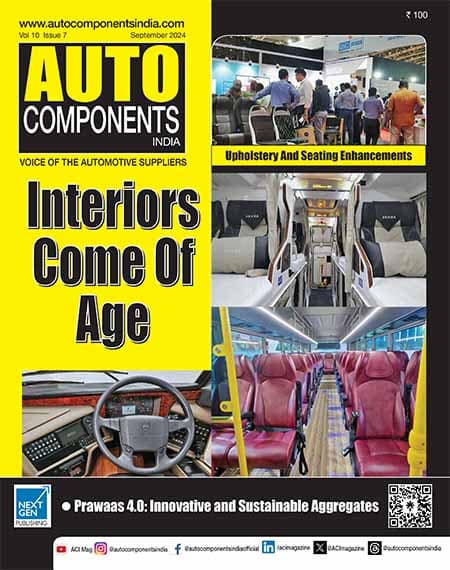Story by: Bhargav TS
Manufacturers want to minimise noise and vibration from the exhaust systems of the new generation cars, and even commercial vehicles, to offer maximum comfort to the passengers and customers. This is made possible by decoupling engine from the exhaust system and allowing specified movement by employing flexible coupling elements. Witzenmann India, the wholly-owned subsidiary of the Germany-based Witzenmann Group, is a leading manufacturer of flexible metal tubes, expansion joints, metal bellows and other automotive components. It has expanded its Chennai plant with an additional line to manufacture expansion joint pipe assembly and cooling supply systems.
The automotive sector, which contributes 85% of the company’s India business, is growing strongly with the upcoming BS-VI emission norms. In addition to the auto sector in India, the company aims to gain business for its products from the railways, aerospace and chemical industries. It is also targeting the export markets, especially China where several European OEMs have their manufacturing facilities.
“Our automotive business has been growing rapidly over the past few years. We anticipate this growth to continue, going forward, with new emission norms round the corner. We are catering to all the automotive OEMs in India with a significant market in our product segments. YoY in the automotive sector we are growing at around 20%. India is a fast growing economy and analysts predict that India will be the number 3 by 2030. This will give us big boost. We are also planning to bring new products to India which will have a niche market initially. Currently we are expanding in the automotive sector especially in the engine-related pipes and piping systems, where we are a larger player in the European market,” said V Chandrasekhar, President and CEO, Witzenmann India Pvt. Ltd.
In India, Witzenmann has 2 facilities, each in Chennai and Kolkata. Witzenmann India has a strong presence in the passenger car segment with over 50% market share in the supply of exhaust gas decoupling elements, exhaust gas duct and exhaust gas recirculation lines to key OEMs including Hyundai Motor India, Maruti Suzuki India, Mahindra & Mahindra, Honda Cars India, Tata Motors, Renault India and others.
The company believes that the BS-VI norms will help it enhance its connect with India’s commercial vehicle segment and is working closely with the CV manufacturers.
In the last 10 years Witzenmann India manufactured more than 10 million decoupling elements for cars and commercial vehicles for the local market. This success story is now to be continued in the industrial and rail transport sectors as well. So far the group has invested about Rs 800 million in both the facilities. “The automotive and commercial vehicle industry of the subcontinent is also growing at a high rate. In order to meet the growing customer requirements, we are expanding the existing liner and hydraulic bellows production units and adding a new assembly line,” Chandrasekhar said.
The decoupling element connects the “moving” engine section of the exhaust gas system with the “rigid” area of the vehicle. This is primarily to compensate for the relative (tilting) movements of the engine which occur especially with transverse fittings. With the decoupling element, the gas-conducting components such as the manifold and the down pipe are relieved from mechanical tension to the extent that the principle of lightweight construction can be implemented here.
To decouple the engine vibrations, the vehicles engine/transmission is elastically connected to the chassis via the engine mounts. With changing output torque, load changes lead to a typical engine pitching in vehicles with front wheel drive and an engine rolling in vehicles with rear wheel drive. In contrast, poor road excitations mainly result in irregular, mainly translational engine movements. Both engine movements caused by load changes and those induced by poor road excitations lie below 20Hz.
Established in 2001, Witzenmann India started catering to the industrial sector with high-quality products such as metal hoses, expansion joints, metal bellows, pipe supports and hangers. In 2006, a metal bellows assembly operation was set up in Kolkata. In 2008, the company set up the manufacturing facility in Chennai to cater to its first automotive customer – Hyundai Motor India. On starting manufacturing and assembly in 2008, the Tier II supplier’s products found their way into the Hyundai i10 and later into the i20. After bagging the Hyundai orders, the company got new business from Fiat, Volkswagen and Tata Motors.
The local manufacturing of bellows and liners this year has helped the company achieve complete localisation of its automobile exhaust decouplers. The company, which started with supplies of 200,000 decouplers to Hyundai per annum in 2008, today caters to all the major OEMs.
Commercial Vehicles
Witzenmann’s success in the passenger car segment has also garnered the attention of commercial vehicle manufacturers and has led to the company bagging orders from the German truck major, Daimler for its BharatBenz brand. “When the BS-VI norms are in place, the flexible components will be in huge demand, especially for the commercial vehicles. For this, we have wide range of products, including the requisite flexible elements that are curved and ready-made for the individual application. Cast-iron connectors, firmly welded to the thin-walled stainless steel offer an additional technological advantage that allows optimal solutions to be attained even in extremely difficult assembly scenarios,” BS Karthic, Team Manager, Sales, Witzenmann India, said.
In CVs, the company will be increasing its market share in the coming years, and for passenger cars it will retain the current share. To grow further it is targeting railways, large engines, agriculture equipment, and off-road equipment. “This will open a large market share,” he said.
In order to reduce the weight of the products that Witzenmann manufactures, it has worked on an alternative technology which is called spherical joint, which saves weight by 50%. Going further, the company will be focusing only on flex tubes. Karthic said, “When we started supplying, the parts were stiffer than the new generation ones. So we decided to offer spherical joint, which saved weight and offered great flexibility. In future, we are planning to use less thick sheet metal to decrease weight. Flexible exhaust gas lines contribute significantly to reduce nitrogen oxides in the combustion process. In oil, fuel and cooling circuits, the advantages of flexible metal lines are their absolute gas and diffusion tightness, long life span and temperature resistance. An essential criterion, especially when they are being built close to exhaust manifolds, turbochargers or the exhaust system.”
Expansion
In terms of volumes, this year, Witzenmann is making 2 million decouplers and currently utilising 80% of the installed capacity. Currently major production volume of around 6.5-7 lakh is for Hyundai, and 6 lakh for Maruti Suzuki. Now it is the 100% supplier to Hyundai and is eying a big share of business from other OEMs as well. “We started with 200,000 parts per year and today we are at 2 milllion. We always want to have room for current capacity utilisation and a third round of expansion is happening in the existing space. Last year growth was higher owing to exports to Ford in Thailand and Suzuki in Japan. “In the first year we recorded a turnover of Rs 20 crore and this year we are targeting Rs 100 crore. Last year, we touched Rs 70 crore,” Chandrasekhar said.













